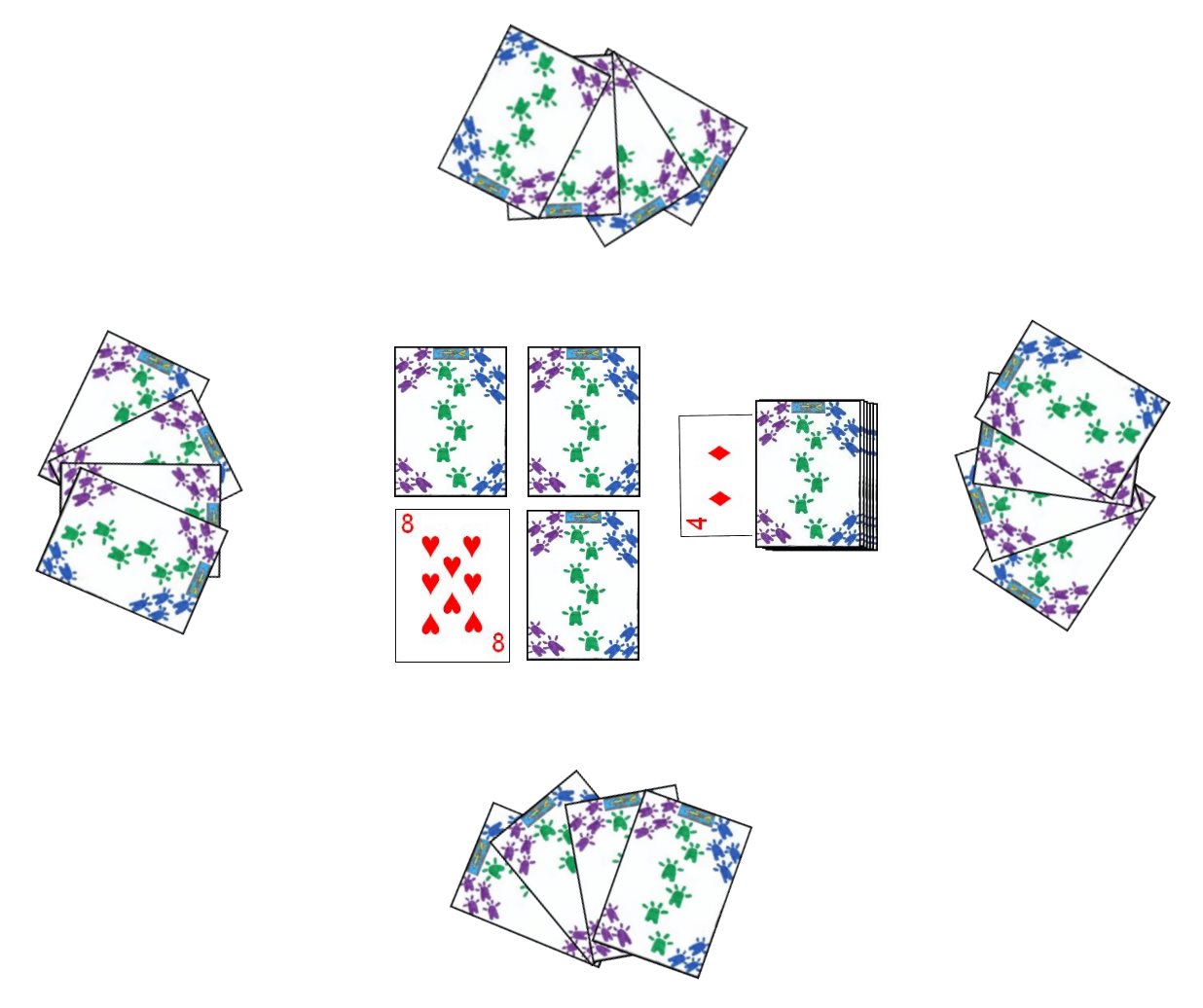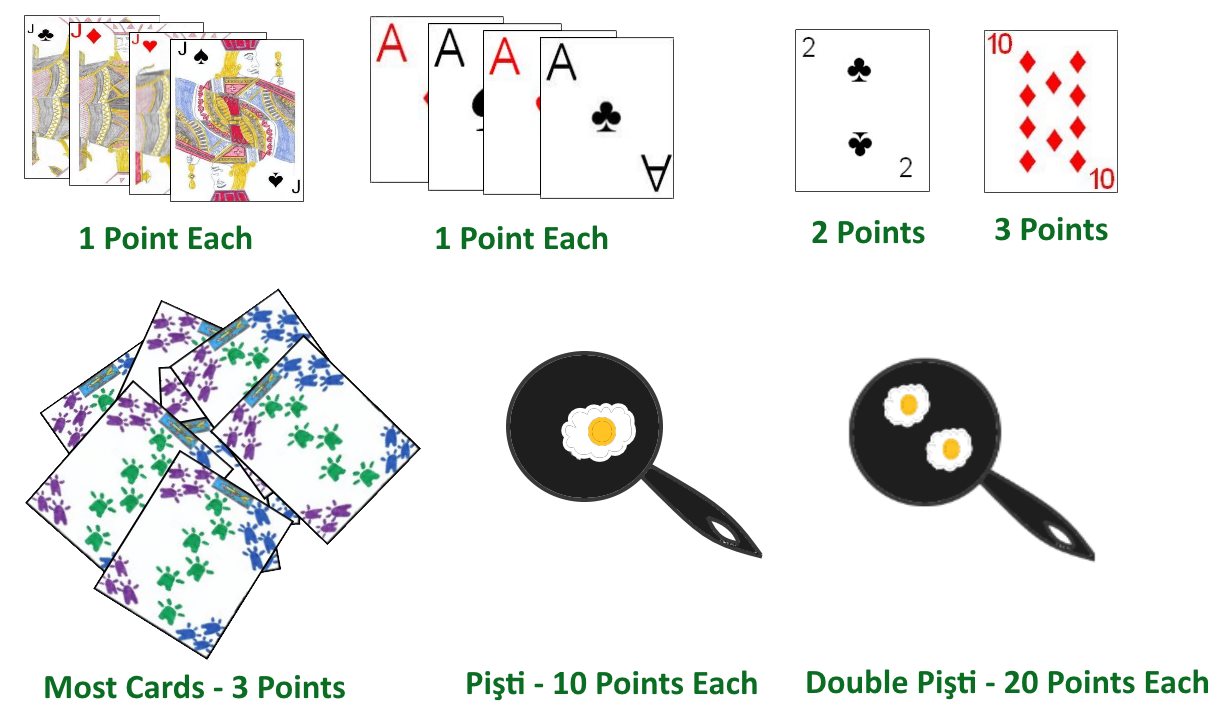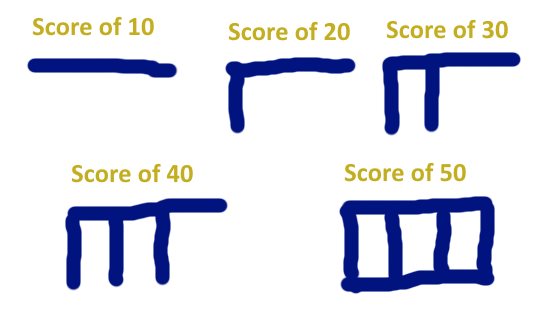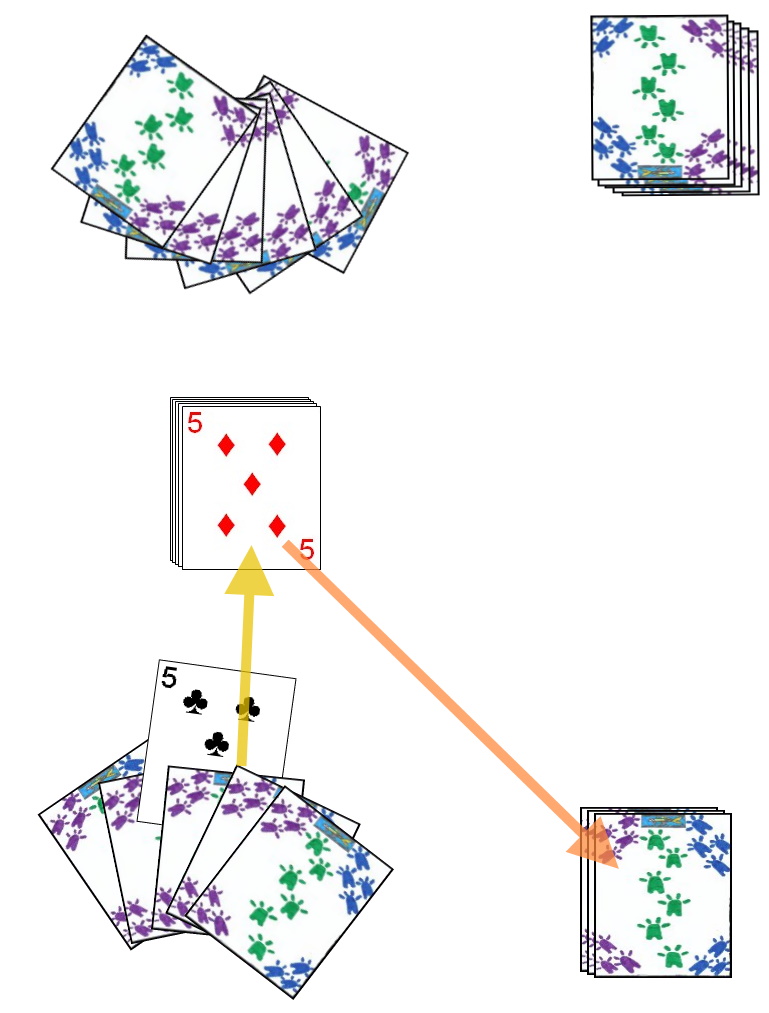Pişti is a fun and unique game of the Fishing family which was originally
enjoyed in Turkey and is still widely played there. The game carries some relations to the game Basra. This game is also sometimes played under the name Pişpirik.
Pişti is a four player partnership game and is played using one standard 52 card deck. Partnerships and the first dealer can be determined in a variety of ways, with drawing for high cards a common method. Thus, each player would draw a card from a shuffled face-down deck and the players drawing the two highest cards would play as partners against the players drawing the two lowest cards. The player drawing the highest card of all would be set as the first dealer. The players should set at the table in such a manner that his partner is directly across from him at the table.
Once the players are seated and the first dealer determined, the dealer should then thoroughly shuffle the deck. After shuffling, he then offers the deck to the player at his immediate left. This player then cuts the deck by removing a portion of the deck and looking at the bottom card of that portion. If this card is a Jack, he then moves it aside to look at the next card, continuing until the card found is not a Jack, and places the non-Jack at the bottom of this cut section of cards he has pulled from the main deck. The dealer then places this cut portion of the deck on the table and places the remainder of the deck on top to complete the cut.

The dealer then deals four face-down cards onto the table, and then a packet of four face-down cards to each player beginning with the player to his immediate right and continuing in a counter-clockwise direction. He then removes the bottom card of the pack (which is the card that the cutting player had viewed when cutting the pack) and places it face-up on the table and then places the remainder of the stock face down partially covering this card, at a ninety degree angle to that card. The dealer completes the deal and setup by turning over any one of the four face-down individual cards in the center of the table to start the discard pile. If this card is a Jack, the dealer then turns over another (leaving the first Jack exposed), continuing until a non-Jack is exposed, with this card becoming the first and bottom card of the discard pile. If, in the extreme rare case all four of the cards turned over on the table are Jacks, the cards are all thrown in and a new shuffle and deal is performed.
The player to the immediate right of the dealer has the first turn, and the turns progress in a counter-clockwise direction around the table from player to player. On a players turn, he must play one card from his hand face-up to the top of the discard pile. If the card played is of the same rank as the current top card of the pile, that player captures the entire pile for his team, placing these captured cards off to the side to be later examined for scoring purposes at the end of the hand. If the card played is a Jack, the player is also entitled to capture the entire pile for his team. If the card is not a Jack and not a card of the same rank as the top card of the discard pile, he simply leaves the card on the pile, which becomes the new top card of the discard pile. After a player captures the pile, the next player in turn must play any card from his hand face-up to the table to start a new discard pile. The team who is first able to capture a pile of one or more cards from the table is also entitled to the other three cards that were originally dealt face-down to the table, adding those cards to his team's capture pile. When taking these cards, the capturing player is allowed to view the value of these face-down cards and may also show them to his partner for the hand.
When each of the players has played the last of his four cards from his hand, the dealer then deals four more face-down cards to each player and replaces the stock
pile back on the table. The exposed card which was placed partially under the stock is considered the last card of the deck and will be dealt to the dealer as part of dealing out further cards during the hand.
If the pile consists of exactly one card (of any suit and rank), and a player, on his turn, manages to capture that card by playing a card of the same rank, he not only captures the two cards, but also scores 10 bonus points to be awarded at the end of the hand. This is called a Pişti (translated from Turkish to mean "cooking"). To indicate this and help the team recall having captured a Pişti, one of the cards from the captured cards should be placed face-up in the capture pile. If the card was a Jack, and the player plays another Jack, capturing it, his team scores for a double Pişti instead, which nets his team 20 points. A Pişti can be accomplished by a team at any point in the game except for the second card played in the entire hand and the last card played in the entire hand. In those cases, the pile can still be captured, it simply does not score any bonus points for a Pişti.
The game continues in this manner until the deck is exhausted and the players have played the last of their cards. After this occurs, any remaining cards on the table are given to the team who was last able to make a capture from the table. After all cards have been played, the scoring for the hand occurs. The following shows the potential points that can be scored during the hand:

|
|
| Scoring Event | Point Value |
|---|
| Each Jack Captured | 1 Point |
| Each Ace Captured | 1 Point |
| Capturing the two of Clubs (♣) | 2 Points |
| Capturing the ten of Diamonds (♦) | 3 Points |
| Team Capturing the Most Total Cards | 3 Points |
| Each Pişti | 10 Points |
| Each Double Pişti | 20 Points |
|
If each team captures exactly 26 cards, neither team earns the 3 points for Most Total Cards on this hand. The deal passes in a counter-clockwise direction around the table and the game continues until one team manages, at the end of a hand to accumulate 151 or more points,
after which that team is declared the winner of the game. If, at the end of a hand, both teams have earned over 151 points, the partnership with the higher total is declared the winner.
 Scoring Mechanism:
Scoring Mechanism: The traditional method of keeping the score for this game is to record a series of tally marks for each team on a sheet of paper. A form of shorthand is used to keep a running score. Each accumulation of ten points is recorded by drawing a line. The first group of ten is thus drawn as a horizontal line, the second accumulation of ten points is a vertical line connected to the first horizontal line, the third ten a second vertical line and the fourth ten points a third vertical line. The next accumulation of 10 points would then be recorded as second horizontal line creating a crosshatched box or gate. Scores of less then ten are usually recorded at individual numbers at the bottom of the page, and when they equal or exceed ten, the appropriate tally can be added to the players total and the individual numbers adjusted as needed.
Individual Pişti: This game can also be played as a non-partnership version of the game. In this version each player plays for himself and keeps his own, individual ongoing score. This game can be played by 2, 3, or 4 players and in all other aspects the game is played identically to the standard partnership version described above.
 Bluffing Pişti
Bluffing Pişti: Another variant of Pişti which is sometimes encountered is Bluffing Pişti. This version is played identically to the standard game as described above, however with one key difference as follows:
If there is just one face-up card on the table, the player whose turn it is may opt to play his card face-down on top of the card, claiming it is the same rank as the card on the table (claiming a Pişti). The player who played the card on which this player
had played his card on, may elect to challenge this player that the card played is actually a card of the same rank. If he does not challenge, the player of the card automatically scores a Pişti and captures both cards, and adds the cards to his capture pile, not required to show the cards to any other players. However, if challenged, the card played is exposed. If the card really was the card claimed (matching the previous card) the player of that face-down cards scores 20 points for the Pişti. However, if the card played is not as claimed, the challenging player scores 20 points instead. In that case, both cards remain on the table and play continues as normal. A player can also do the same thing if the face-up card on the table is a Jack, playing his card face-down, claiming it to also be a Jack. If unchallenged by the previous player, he scores 20 points for the double Pişti. If challenged and the card actually is a Jack, the player of the second Jack scores 40 points. However, if the second card is not a Jack, the challenging player scores the 40 points.
Xeri: Xeri is a Greek game of the fishing family which plays somewhat
similar to Pişti as described above. It also has a number of
similarities to other Greek games similar to Cassino, such as Kontsina and Diloti. Xeri is designed for play by two using one standard 52 card deck.
Any method can be used to determine the first dealer and seating positions, with
a draw for high cards commonly used. Once the first dealer has been determined, the role of dealer should then alternate amongst the two players after every hand.
Once the dealer has been determined, this player should then thoroughly shuffle the deck and offer it to his opponent for the cut. After the cut, the dealer then begins dealing the cards, starting with his opponent. The dealer thus alternately deals the cards on by one and face down to each player (although some player prefer to deal the cards in batches of two or three cards
each), continuing to deal until each player has a total of six cards to form his initial hand. The dealer then deals four cards, one by one, face up to a center pile, with each card played directly on top of the previous card. This center pile is called the play pile. The remainder of the deck is set aside in a face-down pile as the stock
(or talon) to be used later during the hand. After these four initial cards are dealt, if the top card of this play pile is a Jack, or the top two cards of the play pile are of the same rank (i.e. two fives), all four cards of the current play pile are shuffled back into the stock and four new cards are dealt to form a new play pile. If this
new pile also is headed by a Jack or two cards of the same rank, the pile is again shuffled into the pack, this continuing until the top card is not a Jack and the top two cards are not of the same rank.

After the deal, play of the hand begins, with the dealer's opponent having the first turn, and thereafter the turns alternating amongst the two players. Each turn consists of the player playing exactly one card from his hand, face-up to the top of the play pile. He may play any card from the hand, with the usual goal to capture cards from the play pile by playing certain matching cards. Depending on the current top card of the play pile, this play can have one of various results:
- If the play pile is currently empty (due to the cards of the play pile previously having been captured), the card is left in the center of the table to start a new play pile.
- If the play piles contains two or more cards, and the card played is of the same rank as the current top card of the play pile, the player captures the entire play pile, including the card he just played, adding it to his pile of cards captured during the hand.
- If the play pile consists of exactly one card, and the player plays a card of that same rank, he also captures the play pile (including his card played). This is called a Xeri and also entitles the player to bonus points at the end of the hand. In order to signify a Xeri, the capturing player should place one of the captured cards face-up in his capture pile and at a right angle to the other cards in the pack.
- If a player plays any Jack to the top of the play pile, he is entitled to capture his played Jack as well as the entire play pile, adding these cards to his capture pile. If there is only one card on the top of the play pile, this does not score as a Xeri, unless the lone card on the play pile was also another Jack.
- If the card played is not a Jack, and the card played does not match, in rank, the top card of the play pile, the card is simply left as the new top card of the play pile.
All cards captured should be added to that player's capture pile which is kept face-down, and players may never review the cards in this pile until the end of the hand. Once the players have played the original six cards as dealt, the dealer then deals six more cards to each player, setting the remainder of the stock aside for additional deals. This continues until the last cards have been dealt from the deck, and the players continue the game using the last cards from the hand. Once the stock pile has been depleted and the players have played the last of the cards from their hands, the hand ends. Any cards left in the play pile are then taken by the player to have last made any type of capture from the play pile during this hand and added to his capture pile.
Copyright © 2015 CatsAtCards.com. All rights reserved.
 The dealer then deals four face-down cards onto the table, and then a packet of four face-down cards to each player beginning with the player to his immediate right and continuing in a counter-clockwise direction. He then removes the bottom card of the pack (which is the card that the cutting player had viewed when cutting the pack) and places it face-up on the table and then places the remainder of the stock face down partially covering this card, at a ninety degree angle to that card. The dealer completes the deal and setup by turning over any one of the four face-down individual cards in the center of the table to start the discard pile. If this card is a Jack, the dealer then turns over another (leaving the first Jack exposed), continuing until a non-Jack is exposed, with this card becoming the first and bottom card of the discard pile. If, in the extreme rare case all four of the cards turned over on the table are Jacks, the cards are all thrown in and a new shuffle and deal is performed.
The dealer then deals four face-down cards onto the table, and then a packet of four face-down cards to each player beginning with the player to his immediate right and continuing in a counter-clockwise direction. He then removes the bottom card of the pack (which is the card that the cutting player had viewed when cutting the pack) and places it face-up on the table and then places the remainder of the stock face down partially covering this card, at a ninety degree angle to that card. The dealer completes the deal and setup by turning over any one of the four face-down individual cards in the center of the table to start the discard pile. If this card is a Jack, the dealer then turns over another (leaving the first Jack exposed), continuing until a non-Jack is exposed, with this card becoming the first and bottom card of the discard pile. If, in the extreme rare case all four of the cards turned over on the table are Jacks, the cards are all thrown in and a new shuffle and deal is performed.

 Scoring Mechanism: The traditional method of keeping the score for this game is to record a series of tally marks for each team on a sheet of paper. A form of shorthand is used to keep a running score. Each accumulation of ten points is recorded by drawing a line. The first group of ten is thus drawn as a horizontal line, the second accumulation of ten points is a vertical line connected to the first horizontal line, the third ten a second vertical line and the fourth ten points a third vertical line. The next accumulation of 10 points would then be recorded as second horizontal line creating a crosshatched box or gate. Scores of less then ten are usually recorded at individual numbers at the bottom of the page, and when they equal or exceed ten, the appropriate tally can be added to the players total and the individual numbers adjusted as needed.
Scoring Mechanism: The traditional method of keeping the score for this game is to record a series of tally marks for each team on a sheet of paper. A form of shorthand is used to keep a running score. Each accumulation of ten points is recorded by drawing a line. The first group of ten is thus drawn as a horizontal line, the second accumulation of ten points is a vertical line connected to the first horizontal line, the third ten a second vertical line and the fourth ten points a third vertical line. The next accumulation of 10 points would then be recorded as second horizontal line creating a crosshatched box or gate. Scores of less then ten are usually recorded at individual numbers at the bottom of the page, and when they equal or exceed ten, the appropriate tally can be added to the players total and the individual numbers adjusted as needed.

 After the deal, play of the hand begins, with the dealer's opponent having the first turn, and thereafter the turns alternating amongst the two players. Each turn consists of the player playing exactly one card from his hand, face-up to the top of the play pile. He may play any card from the hand, with the usual goal to capture cards from the play pile by playing certain matching cards. Depending on the current top card of the play pile, this play can have one of various results:
After the deal, play of the hand begins, with the dealer's opponent having the first turn, and thereafter the turns alternating amongst the two players. Each turn consists of the player playing exactly one card from his hand, face-up to the top of the play pile. He may play any card from the hand, with the usual goal to capture cards from the play pile by playing certain matching cards. Depending on the current top card of the play pile, this play can have one of various results: